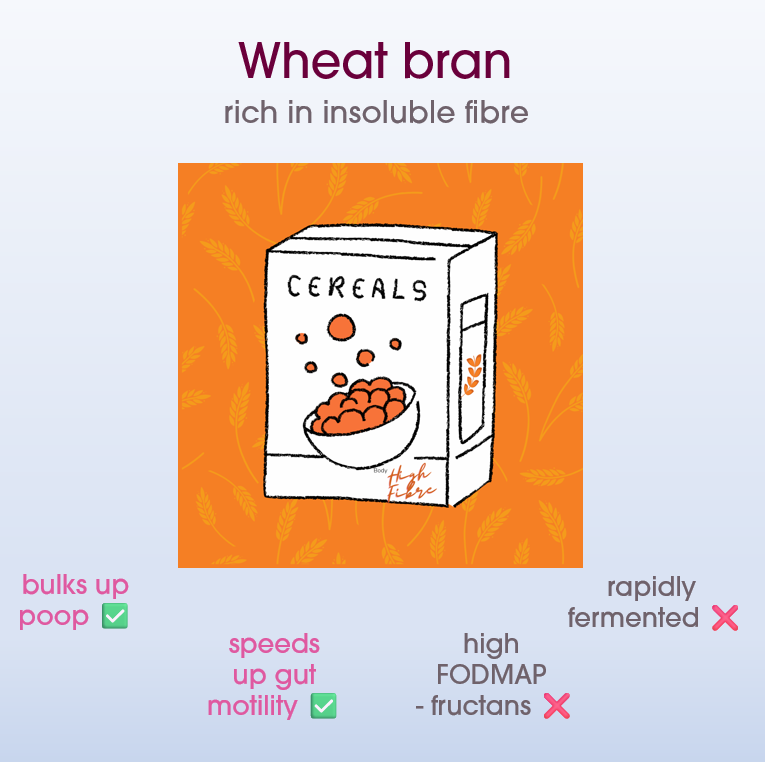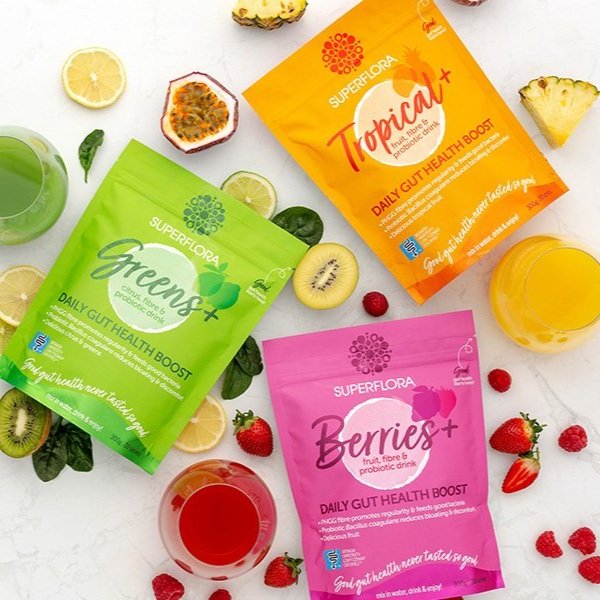Gut-friendly products that aren’t always gut friendly
In this blog we are going to talk about one of our pet peeves – the ‘gut-friendly’ products that simply aren’t gut-friendly if you have IBS or a sensitive tummy.
As we walk through the supermarket aisles and scan the shelves in our local pharmacy, we see a lot of labels that suggest gut health benefits and yet the products contain ingredients that simply aren’t suitable for the people most likely to be seeking out improvements in gut health. They may be great for people with already healthy guts, but they can make your life very miserable if you have irritable bowel syndrome (IBS) or a sensitive tummy.
And that is a lot of people. It’s worth reminding ourselves about that because it’s IBS awareness month. IBS is a debilitating condition, it causes abdominal pain, bloating and constipation or diarrhoea, or a mix of the two. It isn’t related to structural changes in the gut, but it is a chronic condition without any cure. Thankfully, it can be managed with dietary and lifestyle changes. Estimates of IBS prevalence across the globe vary between 7% and 20% – to some extent this depends on the criteria for diagnosis, and these change over time. However, the last large-scale study in Australia, indicated that about 11% of the population have IBS.
In addition, there are also a whole host of people who don’t quite make the cut off for IBS or other gut disorders, but are still troubled by gut symptoms. A recent study across 26 countries found that around 25% of people have sub-diagnostic troublesome gut symptoms – most commonly related to constipation and diarrhoea.
Altogether, that adds up to a lot of people searching the shelves for something to improve their gut health.
In this blog, we’ll take you through the ingredients most likely to cause problems, the different names they hide under, explain why they are problematic (for some) and tell you what to look out for instead.
This blog will be useful for you if you have been diagnosed with IBS and have worked out that foods containing fructans are a trigger for symptoms, or if you generally have a tendency towards bloating and abdominal pain.
But first a little context about fibre…
Fibre is good right?
Yes, fibre is good for you. It helps you poop easily and has other benefits including improved blood sugar control and lowering cholesterol. It also has indirect effects through feeding the good bacteria that live in our guts. We can’t break down or digest fibre, but our good gut bacteria can break it down (ferment it) into beneficial compounds like short chain fatty acids. Adequate daily amounts of fibre (for regular poops) are 25g for women and 28g for men, whilst more is needed to reduce chronic disease risk - 28g for women and 38g for men.
But fibre comes in different forms. And this is where folk with IBS need to tread a fine line. There are different types of fibre, for example, soluble and insoluble (more on that later) and rapidly fermented and more slowly fermented fibre. Many manufacturers of gut health foods and supplements add forms of fibre that are rapidly fermented and just don’t suit people with IBS.
Inulin
One of the most popular additions is inulin. Inulin is a type of fructan (a FODMAP). It is rapidly fermented in the large intestine by beneficial bacteria – Lactobacillus and Bifidobacteria. This promotes their growth and their production of the SCFA, butyrate. For people without sensitive tummies this is great, but the fast fermentation also produces a lot of hydrogen which expands the gut. People with IBS have increased sensitivity to pain in the internal organs of the body, so all that gas is experienced as painful bloating. This is not pleasant, and why if you have found avoiding FODMAPs helps reduce your IBS symptoms, you’ll want to ditch any product that has inulin as an ingredient.
Where is it hiding?
A quick search of the local supermarket and pharmacy led to me finding inulin in a chocolate fudge fibre brownie, digestive gummies, a greens and prebiotics fibre powder and probiotic bliss balls. Inulin can also mimic the texture of fat in foods, so it is often used in yoghurts and ice-cream to provide a creamy texture. I found it in a tub of coconut and vanilla yoghurt.
And what are its aliases?
You’ll need to scrutinise ingredient lists carefully to avoid inulin. It is often extracted from chicory root, so you may see it on the ingredient list as chicory root fibre or chicory root extract. It is also sometimes called frutalose, oligofructose, or FOS.
Wheat bran
Another common ingredient in ‘gut-friendly’ products is wheat bran. You will find this in a lot of high fibre breakfast cereals. Again, this is an excellent source of fibre, and a good choice if you don’t have gut problems. It provides insoluble fibre from the tough plant cells walls in the wheat and is great for getting your gut moving. It is also fermented into beneficial short chain acids by your good gut bacteria.
However, wheat bran also contains fructan, a type of highly fermentable oligosaccharide (FODMAP), that can cause problems for people with IBS. It also contains gluten - a big problem if you have coeliac disease.
What to have instead?
This depends on your type of IBS and gut symptoms. If you struggle with abdominal pain and bloating, you’ll want to opt for something that is only slowly fermented, ideally further along the digestive tract so that both you and your gut microbes are kept happy.
You may also need to think about the ratios of soluble and insoluble fibre.
Soluble versus Insoluble Fibre
All fibre is derived from plants – it is essentially all the carbohydrates in our plant-based food that we are unable to digest due to a lack of enzymes. It is either fermented by our gut bacteria or simply passes through us unchanged.
Soluble fibre dissolves in water and includes pectin, gums, mucilage, fructans and some resistant starches.
Insoluble fibre (sometimes called roughage) comes from the building blocks of the tough cell walls of plants - lignin, cellulose, and hemicellulose.
Soluble fibre soaks up water to soften the poop, whilst insoluble fibre, speeds up movement through the gut and bulks up the poop.
Too fast or too slow?
If you have diarrhoea, opt for a little less of the insoluble fibre and more soluble fibre that will ‘soak’ up water to form a gel or sponge.
Our favourite low FODMAP soluble fibre sources are partially hydrolyed guar gum, oats, psyllium, papaya, pumpkin and citrus. Peas, beans, and apples are also rich in soluble fibre, but tend to be higher in FODMAPS.
If you struggle with constipation, you need a mix of both soluble and insoluble fibre. The soluble fibre to soften and add bulk, and the insoluble fibre to get things moving.
You need to drink plenty of water along with your fibre, or it can backfire and make constipation worse.
Nuts, seeds, fruits and vegetable contain a mix of soluble and insoluble fibre. Grinding nuts and seeds reduces the ‘roughage’ to some degree. Legumes also have a mix of soluble and insoluble fibre, but tend to be more rapidly fermented, so low-FODMAP serving sizes are quite small.
The richest sources of insoluble fibre are are whole-grain foods, bran, nuts, and seeds. Brown rice and quinoa, and baked potatoes are good low FODMAP options.
We have more details on low FODMAP serving sizes of different fibre sources in our Best Ever Poop Plan.
If you have diverticulitis, you will need to cut down on fibre when you have a flare up, especially insoluble fibre.
Looking for recipes?
If you often have constipation, try our kiwi chia pots with a crunchy topping. The chia soaks up water to make a soft gel and the nuts and seeds speed up movement through the gut and add extra bulk. Kiwi fruit are a good source of soluble and insoluble fibre and are clinically proven to help with constipation.
If you are prone to diarrhoea, a better breakfast choice is porridge or overnight oats. You could also try upping your intake of papaya and pumpkin.
If you are looking at supplements, swap the soluble inulin for another soluble prebiotic fibre like PHGG. Swap wheat bran for psyllium husks.
Delicious fibre options for sensitive tummies
There are fibre-filled options that strike a balance and keep both you and your gut microbiome happy.
Our Superflora gut-friendly shakes include 7g of fibre per serve. We used gentle fibre sources that feed your good gut bacteria, but aren’t rapidly fermented: ground chia and flax seeds, psyllium and PHGG. Choose from strawberry, chocolate and vanilla flavours, all have been tested and certified Low FODMAP by Monash University. They are also gluten-free.
Quick and easy option
Our Daily Gut Health Boost drinks are another low FODMAP and gluten-free option. Each serve contains 5g of PHGG, a prebiotic, soluble fibre. It is fermented by your good gut bacteria into short chain fatty acids, but further along the colon than other fibre sources. It is less likely to cause pain and bloating than wheat bran or inulin. We’ve mixed it with a probiotic and delicious fruit powders for a great natural taste.
Written by: Dr Mary Webberley, Chief Scientific Officer at Noisy Guts. Mary has a background in biology, with two degrees from the University of Cambridge and post-doctoral research experience. She spent several years undertaking research into the diagnosis of IBS and IBD. She was the winner of the 2018 CSIRO Breakout Female Scientist Award.
References:
Soliman, G. A. Dietary Fiber, Atherosclerosis, and Cardiovascular Disease. Nutrients 2019, 11, 1155; DOI:10.3390/nu11051155
Palsson O. S. et al., Worldwide population prevalence and impact of sub-diagnostic gastrointestinal symptoms. Aliment Pharmacol Ther. 2024;59:852–864; DOI: 10.1111/apt.17894






